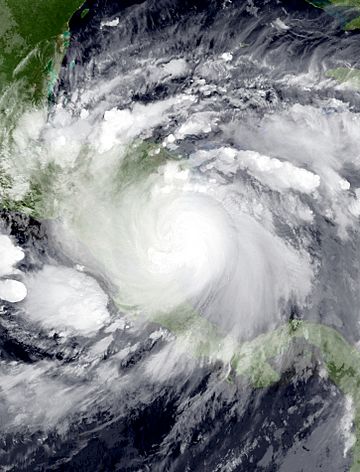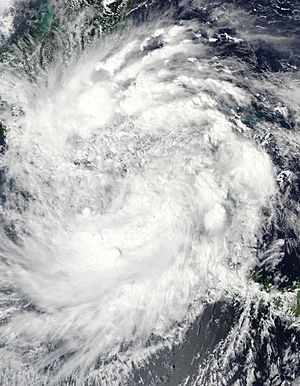Hurricane Julia (2022) facts for kids
| Category 1 hurricane (SSHWS/NWS) | |

Hurricane Julia at peak intensity while making landfall in Nicaragua on October 9
|
|
| Formed | October 7, 2022 |
|---|---|
| Dissipated | October 10, 2022 |
| Highest winds | 1-minute sustained: 85 mph (140 km/h) |
| Lowest pressure | 982 mbar (hPa); 29 inHg |
| Fatalities | 83 total, 52 missing |
| Damage | Unknown |
| Areas affected | Trinidad and Tobago, Venezuela, ABC islands, Colombia, Nicaragua, El Salvador, Honduras, Guatemala, Panama, Mexico |
| Part of the 2022 Atlantic and Pacific hurricane seasons |
|
Hurricane Julia was a strong tropical cyclone that hit Central America in October 2022. It was a Category 1 hurricane, meaning it had very strong winds. Julia was the tenth named storm and fifth hurricane of the 2022 Atlantic hurricane season.
The storm started as a tropical wave in the Atlantic Ocean. It became a named storm on October 7. Julia moved south through the Caribbean Sea, passing near the coast of Venezuela. Only one other storm, Tropical Storm Bret in 1993, has traveled further south over South America. On October 8, Julia grew into a hurricane and hit Nicaragua.
After crossing Nicaragua, Julia moved into the Pacific Ocean on October 10. It became a tropical storm there. This made it the second storm of the 2022 Pacific hurricane season to move from the Atlantic to the Pacific, after Bonnie. Julia then moved along the coast of El Salvador. It later moved inland and weakened over Guatemala on October 10. Julia caused heavy rains, which led to dangerous flash floods and deadly mudslides in Venezuela and Central America.
Contents
How Hurricane Julia Formed and Moved
On October 2, weather experts started watching a tropical wave in the central Atlantic. A large area of low pressure formed on October 4. This happened as it got closer to the southern Windward Islands. Because this developing storm could threaten land, the National Hurricane Center (NHC) began issuing warnings on October 6. They called it Potential Tropical Cyclone Thirteen.
Later that day, satellite images showed the storm was getting stronger. It had enough circulation and organized thunderstorms. Special planes called "hurricane hunters" also found winds of 25–30 knots (29–35 mph; 46–56 km/h) near its center. Because of this, it was named a tropical depression. Early on October 7, strong thunderstorms grew near the center as it moved across the Guajira Peninsula. Soon after, it became Tropical Storm Julia.
The storm continued to gain strength. Julia became a hurricane at 7:00 PM UTC on October 8. It reached its strongest point at 10:00 PM UTC on October 8. At this time, its winds were 75 knots (86 mph; 139 km/h). Its lowest central pressure was 982 mbar (29.00 inHg). At 3:15 AM UTC on October 9, the hurricane hit land near Pearl Lagoon, Nicaragua, with the same strength.
Julia then slowly weakened to a tropical storm as it moved across Nicaragua. It still had a clear center and strong thunderstorms. Late on October 9, Julia left the Atlantic basin and entered the Pacific. Three hours later, its center moved over the Pacific Ocean, where it continued to weaken. At 8:00 AM UTC on October 10, the storm's center crossed the coast of El Salvador. This was about 35 mi (56 km) west of San Salvador. It then weakened to a tropical depression. Later that day, Julia became a remnant low over Guatemala and southeastern Mexico.
How Countries Prepared and Were Affected
| Country | Deaths | Damage (USD) |
|---|---|---|
| Trinidad and Tobago | 1 | Unknown |
| Venezuela | 50 | Unknown |
| Colombia | 0 | Unknown |
| Nicaragua | 3 | Unknown |
| Panama | 2 | Unknown |
| Honduras | 4 | Unknown |
| El Salvador | 10 | Unknown |
| Guatemala | 14 | Unknown |
| Mexico | 1 | Unknown |
| Total: | 83 | Unknown |
Trinidad and Tobago
On October 5, the storm brought heavy thunderstorms to the Windward Islands and the Caribbean coast of South America. More than 2 in (51 mm) of rain fell in Trinidad and Tobago in less than 30 minutes. This caused serious flash floods. One person died after being swept away by a river.
Venezuela
Heavy rain from Julia caused widespread flooding and landslides. In Las Tejerías, a town in north-central Venezuela, at least 50 people died. Another 50 people went missing when mud and debris covered the town. About 3,000 people were sent to search for survivors.
Colombia
The center of Julia passed just south of San Andrés Island. This happened as it was becoming a hurricane east of Nicaragua. At least 174 homes were destroyed by Julia in Colombia. Also, 5,247 homes and a health center were damaged. Luckily, no one died in Colombia.
Central America
Honduras
The government of Honduras opened more than 1,137 shelters across the country. By October 10, about 9,200 people were using these shelters. A red alert, the highest warning level, was issued for 10 of Honduras's 18 regions. Many homes along the Chamelecón River were flooded. The river continued to rise on October 10.
Heavy rains caused water levels at two dams, La Concepcion and Jose Cecilio del Valle, to go above their maximum limits. The Ulúa River rose to 6.79 m (22.3 ft) near Santiago. This was higher than the red alert level for flooding. The worst effects were seen in Yoro Department. In Honduras, Julia killed four people and two others went missing by October 11. A total of 103,960 people were affected, and 3,412 had to leave their homes. Also, 278 homes were destroyed, and 397 more were damaged.
Guatemala
In Guatemala, 457,300 people were affected by the storm. About 1,165 people had to evacuate. At least 14 people died in Guatemala. Nine deaths were in Huehuetenango Department and five in Alta Verapaz Department.
Nicaragua
The hurricane left at least 1 million people in Nicaragua without electricity. It also forced 13,000 families to leave their homes for safety.
Panama
Two people died in Panama near the border with Costa Rica. Around 300 people had to be evacuated. The Ministry of Education in Panama closed schools on October 10. Two landslides were reported. Overall, nearly 868 people were affected by the heavy rains.
El Salvador
On October 8, the government of El Salvador declared an orange alert for the whole country. This was because of the approaching storm. Fishing and fun activities in rivers, beaches, and lakes were stopped until October 11. Shelters were made ready for 3,000 people. A national emergency was declared because of the hurricane.
The government later declared a red alert for civil protection due to the strong winds. Falling trees were reported in different towns. These blocked traffic and damaged cars. Falling branches also blocked several main highways. Roads were also damaged by landslides. Five soldiers died and one was hurt in Comasagua. This happened when the house they were hiding in collapsed. In total, Julia caused ten deaths in El Salvador.
See also
 In Spanish: Huracán Julia (2022) para niños
In Spanish: Huracán Julia (2022) para niños
- List of Atlantic–Pacific crossover hurricanes
- List of Category 1 Atlantic hurricanes
- Timeline of the 2022 Atlantic hurricane season
- Timeline of the 2022 Pacific hurricane season
- Tropical cyclones in 2022
- Weather of 2022
- Tropical Storm Bret (1993) – another deadly storm that moved in a similar way over the northern coast of South America
- Hurricane Otto (2016) – another Atlantic hurricane that took a similar path, later becoming a tropical storm in the Eastern Pacific
- Hurricane Iota (2020) – a very strong hurricane that had a similar path, affecting Central America
- Hurricane Bonnie (2022) – had a similar path and crossed into the Eastern Pacific as a tropical storm three months before Julia


